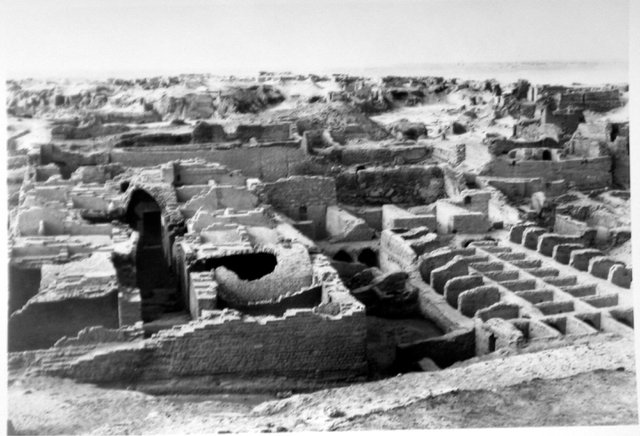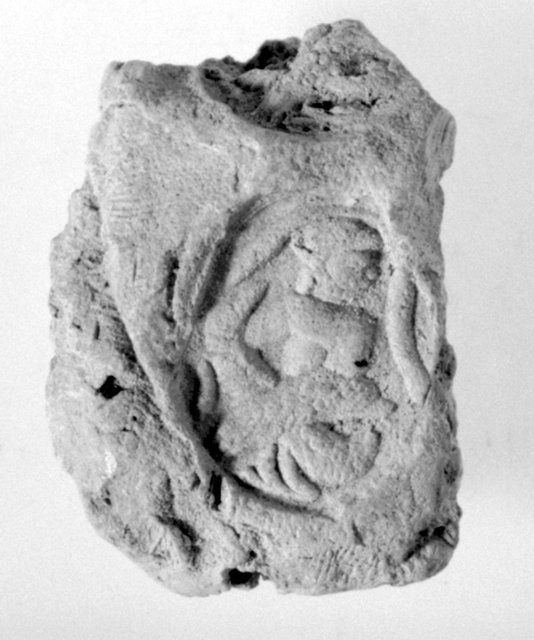- Print article
- Download PDF 105kb
A Clay Sealing from Karanis in the Kelsey Museum
Skip other details (including permanent urls, DOI, citation information)
: This work is protected by copyright and may be linked to without seeking permission. Permission must be received for subsequent distribution in print or electronically. Please contact [email protected] for more information.
For more information, read Michigan Publishing's access and usage policy.


In 1930 excavators from the University of Michigan discovered some of the Kelsey Museum’s smallest artifacts in the cellars and storage bins of Karanis. These tiny chunks of Nile clay bear the impressions of delicately carved stones on one side and of the string and the wooden objects to which they were affixed on the other. They now form part of the Kelsey collection of items recovered from ancient Karanis, a Fayum town that flourished during the period of Rome’s hegemony over Egypt (first century BCE to sixth century CE).
Sealings, often called bullae, are small fragments of mud, clay, or occasionally lead attached to a document or object to prevent tampering. The bullae bearing seal impressions also acted as signifiers of consent, acknowledgment, or responsibility for the papyrus, mummy label, door, box, bag, or amphora to which they were attached (Vandorpe 1993, 231–232; Wilfong 2003, 188). The bullae found at Karanis are related to the storage, shipment, and receipt of grain. In the Fayum, the major agricultural region of Roman Egypt, taxes were paid with portions of local crops of wheat, grain, and barley (Rickman 1980, 113–118). These taxes in kind were gathered by local officials in large buildings called thesauroi that were purpose-built to keep the grain before its redistribution and shipment (Rickman 1971, 298–306). These buildings, common in the larger towns of the Fayum, were both publicly and privately owned (Husselman 1952, 69–71).
As a prosperous settlement amidst especially rich agricultural land, Karanis was a central collection and storage point for both tax and private grain from surrounding villages. In the roughly second–third century CE level of the town, ten large and seven small granaries were discovered along with grain-storage rooms in private houses (Husselman 1952, 58; Milne 1906, 32). The sealings were found in small groups scattered throughout one of the largest granaries, designated “Granary C123” (fig. 1). The total number of sealings recovered in 1930 from Granary C123 is unknown, but 287 were given to the Kelsey Museum, and 33 remained in Egypt in the Cairo Museum collection.[1]
The sealings were found primarily in the southern half of the building, in vaulted storage chambers arranged along either side of an east-west hall. The floors of these rooms were sunk below ground level and divided by walls into discrete bins for storing and preserving grain. The passageways leading to these vaults had a series of trapdoors opening into another smaller group of vaulted chambers below the floor. The sealings were found in clusters throughout these southern rooms, in the vaults below the passageway floors, and in similar structures in the northern half of the building. Each sealing bears multiple impressions of one or sometimes two seal stones, which were impressed on the upper surface of the clay after it had been affixed to another object. The archive includes forty-five different seal impressions. The featured sealing (fig. 2) was part of a group of twenty-three found in one of the sunken bins in a barrel-vaulted room (visible on the lefthand side of fig. 1). It bears two oval impressions of a male figure, possibly Sarapis, with a right-profile head and feet, and frontal torso. His hair is bound by a fillet, and he has a short beard. The figure is composed of highly rounded shapes, with a fleshy face and indistinct features. A hawk is shown in front of the figure in mixed perspective with a profile body and head and frontal wings. The feet of the Sarapis figure emerge below the hawk’s body on a narrow groundline. The hawk, associated with Horus, is often paired with Sarapis, and several other variations on this motif are present in the granary archive (Gates forthcoming; see also Milne 1906, cat. nos. 15 and 16). The position of the hawk mirrors the literal and figurative enveloping of the divine Sarapis, which in turn may evoke the motif of the protective Horus, who is often depicted shielding divine and royal figures (e.g., Robins 1997, 35, figs. 28 and 45). The torso of the Sarapis figure is framed by an irregular garland that curves from below the right wing of the hawk, around the Sarapis figure, and terminates at the hawk’s rounded beak.[2]
This particular seal impression appears on thirty-five sealings in seven different findspots in Granary C123 and is one of the most common seal types in the archive as a whole. It belongs to a cluster of seals that appear consistently in association with one another and may be evidence for a group of merchants or farmers whose products were stored together in spaces throughout Granary C123. This seal impression also appears on bullae with very different reverse impressions, demonstrating that the seal was applied to many different kinds of wooden containers, cloth, and rope. This suggests that the grain arrived at the building in a variety of containers. The bullae were likely deposited when these containers were opened and the grain recorded and redeposited. The pattern of sealing distributions supports the notion that the vaults and bins in Granary C123 were rented by individuals and groups for grain deposit and storage, an arrangement suggested by papyrological evidence (Husselman 1952, 68).
The implications of these tiny artifacts are far-reaching: very little is known about the practice of private or official grain collection and storage in the Fayum. The Karanis sealings provide a window into the economic practices of merchants and farmers who deposited their grain in these large village granaries and the storage and transportation methods they employed. In addition, these sealings shed light on the images and themes chosen by these individuals for what may have been powerful personal and mercantile markers.
Notes
I am grateful to Dr. Paola Davoli for her generous provision of images and descriptions for the Cairo Museum sealings from Karanis.

In addition to my own observations, I have benefited from the catalogue of the granary sealings completed by Robert S. Dill Jr. (n.d.).

Works Cited
Dill, R. n.d. “Small Mud Sealings from Karanis.” Unpublished manuscript, Kelsey Museum of Archaeology.
Gates, J. E. Forthcoming. A Catalogue of the Karanis Sealings in the Kelsey Museum of Archaeology.
Husselman, E. M. 1952. “The Granaries of Karanis.” Transactions and Proceedings of the American Philological Association 83:56–73.
Milne, J. G. 1906. “Clay-Sealings from the Fayum.” The Journal of Hellenic Studies 26:32–45.
Rickman, G. 1971. Roman Granaries and Store Buildings. Cambridge: Cambridge University Press.
———. 1980. The Corn Supply of Ancient Rome. Oxford: Clarendon Press.
Robins, G. 1997. The Art of Ancient Egypt. Cambridge, Mass.: Harvard University Press.
Vandorpe, K. 1993. “Seals in and on the Papyri of Greco-Roman and Byzantine Egypt.” In Archives et sceaux du monde hellénistique [= Archivi e sigilli nel mondo ellenistico], ed. M.-F. Boussac and A. Invernizzi, 231–261. Athens: École Française d’Athènes.
Wilfong, T. 2003. “Stamp Seals and Seal Impressions from the Post-Pharaonic Period.” In Scarabs, Scaraboids, Seals and Seal Impressions from Medinet Habu, ed. E. Teeter and T. G. Wilfong, 188–212. Oriental Institute Publications 118. Chicago: Oriental Institute of the University of Chicago.
